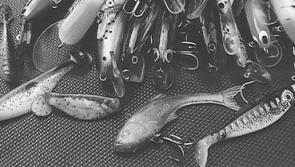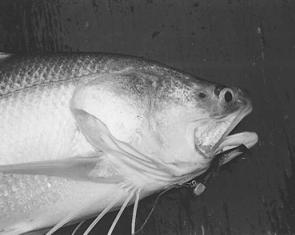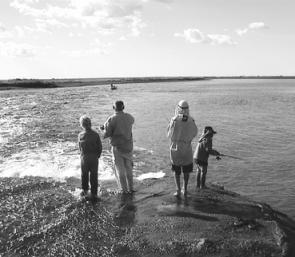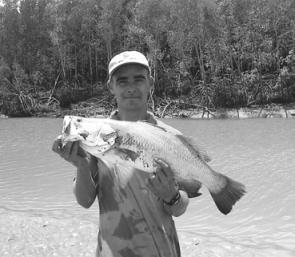With all the high-tech, full-on soft plastic articles doing the rounds at the moment, newcomers to this form of fishing could almost be forgiven for thinking that you need a science degree and a second mortgage to get into it.
There are so many stickbaits, flickbaits and all sorts of trickbaits, as well as a thousand different types of jigheads to choose from. Then you need a million-dollar rod and a spinning reel worth more than my second car just to cast them with. Is it just me or does it make soft plastics sound too hard for ordinary anglers to get their heads around?
Well, the good news is, there is a simple way to fish soft plastics that anyone who has ever thrown a hard-bodied minnow can do with a good chance of success. Best of all, you don’t need to spend any of your hard earned cash on new outfits as long as you have a half decent baitcasting or spinning combo.
I’m talking about tossing jighead rigged soft plastic shads. This approach is about as simple as fishing with soft plastics gets but don’t be fooled, it’s a great way to target everything from flathead to barra, bass and mangrove jack.
The system is simple. First you find yourself a nice looking soft plastic shad. Shads are fish shaped lures that have a rounded paddletail on the end. As you move them through the water, the water pressure causes the tail to wobble from side to side, making the lure swim just like a live baitfish. Because they have their own built-in action, shads don’t need to be ‘worked’ with the rod tip as much as some other types of soft plastics do.
Don’t get too caught up in specific brands or models. As long as it looks fishy and is somewhere between 2-4” long (50 –100mm) it should work. I also believe that the lure body needs to be nice and soft, which some cheaper soft plastics definitely aren’t. The softer the lure is, the better the action tends to be and the more receptive the fish will be. Softer lures will tear more easily but that’s a price I am willing to pay for a lure that works.
Apart from the fact that the hook point needs to be ultra sharp, I don’t get too concerned about selecting specific jigheads either. They should be heavy enough to cast and to get your lure to the bottom but then you don’t want it streaking to the floor. Use the lightest jighead you can cast is my usual rule of thumb. If you aren’t getting bites, you can always try going lighter. Just make sure the hook is sharp and sturdy.
The great point about this sort of soft plastic fishing is that it’s almost the same as fishing with normal hard-bodied minnows. Cast the lure, let it sit for a minute so it sinks, give it a couple of small flicks with the rod tip and then work it back with a slow, staggered retrieve.
Of course it works best when you cast at fish holding structure. It’s dynamite when you know that there are fish holding on the structure that have refused your previous offerings. Bankside snag piles are obvious places to start and a single hooked soft plastic is pretty dam snag resistant, so don’t be afraid to get your casts back in there.
The other place where this presentation works a treat is at the mouths of small creeks and drains running off the tidal mudflats. These places are fish magnets and you will often find small baitfish and prawns hiding in the colour change as the tide lowers. A small soft plastic shad worked patiently through the creek mouth will often bring a lurking predator unstuck and is especially deadly on estuary barra and flathead.
The other good thing about creek and drain mouths is that being an ordinary caster is not really a handicap. It can actually be an advantage. Instead of casting into the water, try casting your shad up onto the bank and then slipping it quietly back into the water. Often it will get hit right on the edge, as soon as it enters the water. Whether the fish take it for a mudskipper, or if they’re fooled by the quiet approach is debatable but it often works on hard-fished waters.
Lure size is important. I’m sure that in the estuaries, most people use lures that are much bigger than they need to be. Even when I regularly fished Darwin Harbour for barra, my first choice of soft plastic was usually a 50mm Mr. Twister Sassy Shad or Grub. These are a 2” plastic with a shad tail and I have caught hundreds of harbour barra on them. A 2” lure is certainly big enough to interest typical harbour fish from legal size to around 80cm. Even when I wanted a bigger lure, a 3” Sassy Shad was all I used. These are only 75mm long and fish to 1m will happily scoff them in harbour/river/estuary waters. Finally, don’t ignore the old Vibrotails. They’re a great size and are very soft and supple. Barra still love them.
In tidal waters I don’t get too hung up on colour choice. Plain or pearl white will often be just as good as the most elaborate colour scheme. I have caught fish on shads in just about every colour of the rainbow and as long as your lure moves right and is put in the right place, the fish will eat it. The only exception is threadfin salmon that will occasionally eat clear plastics with metallic fleck through them. Not often enough for my liking, but when the fish are refusing everything else, see-through lures can sometimes do the trick.
Mentioning brands is always fraught with pitfalls but as well as Mr. Twisters and Vibrotails, I have also had good success with AusSpin, Squidgy and Renosky shads. If you are looking for a lure at the larger end of the scale, then it’s hard to go past the Panther Martin Vivif. Vivifs have the largest double lobed paddletail I have seen and put out great vibrations. In muddy or fast flowing water they are hard to beat.
Your rod and reel needs to be spooled with non-stretch braid. This sort of fishing is all about feel and only braid transmits all those subtle little bumps and knocks from interested fish.
River2Sea Shad, Renosky, Mr. Twister Shassy Grub and a small Panther Martin Vivif.
Reads: 8029
A few successful soft plastic shads. (L-R) Mr. Twister Sassy Grub, Mr. Twister Shassy Shads (75 and 50mm), Mann’s Georg’n Shad and a Renosky shad.

A solid threadfin salmon on a small, clear soft plastic shad. The rewards for flicking a plastic around a tropical creek mouth.

Some anglers fishing the freshwater side of Shady Camp in the Northern Territory. Literally thousands of barra are caught on soft plastic shads here.

Barra like this saltwater fish taken in the Howard River opposite the Shoal Bay Boat Hire ramp are real suckers for smaller soft plastic shads.




